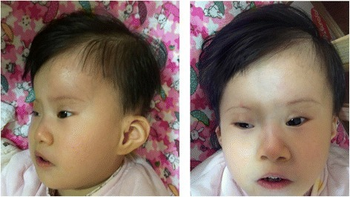Trisomy 9
| Trisomy 9 | |
|---|---|
 | |
| Chromosome 9 | |
| Specialty | Genetic medicine |
Full trisomy 9 is a lethal chromosomal disorder caused by having three copies (trisomy) of chromosome number 9. It can be a viable condition if trisomy affects only part of the cells of the body Mosaic trisomy 9 [1]or in cases of partial trisomy, Trisomy 9p in which cells have a normal set of two entire chromosomes 9 plus part of a third copy, usually of the short arm of the chromosome (arm p).
Signs and symptoms

Symptoms vary, but usually result in dysmorphisms in the skull, nervous system problems, and developmental delay. Dysmorphisms in the heart, kidneys, and musculoskeletal system may also occur. An infant with complete trisomy 9 surviving 20 days after birth showed clinical features including a small face, wide fontanelle, prominent occiput, micrognathia, low set ears, upslanting palpebral fissures, high-arched palate, short sternum, overlapping fingers, limited hip abduction, rocker bottom feet, heart murmurs and a webbed neck.[2]
Trisomy 9p is one of the most frequent autosomal anomalies compatible with long survival rate. A study of five cases showed an association with Coffin–Siris syndrome, as well as a wide gap between the first and second toes in all five, while three had brain malformations including dilated ventricles with hypogenesis of the corpus callosum and Dandy-Walker malformation.[3]
Diagnosis
Trisomy 9 can be detected prenatally with chorionic villus sampling and cordocentesis, and can be suggested by obstetric ultrasonography.[citation needed]
Because trisomy 9 may appear with mosaicism, it is suggested that doctors take samples from multiple tissues when karyotyping for diagnosis.[4]
Treatment
In terms of mosaic trisomy 9 management is toward the specific symptoms that each individual experiences.[5]
References
- ↑ "Mosaic trisomy 9 - About the Disease - Genetic and Rare Diseases Information Center". rarediseases.info.nih.gov. Archived from the original on 18 May 2021. Retrieved 23 June 2022.
- ↑ Kannan, T. P.; Hemlatha, S.; Ankathil, R.; Zilfalil, B. A. (2009). "Clinical manifestations in trisomy 9". The Indian Journal of Pediatrics. 76 (7): 745–6. doi:10.1007/s12098-009-0158-2. PMID 19475342. S2CID 207385217.
- ↑ Temtamy, SA; Kamel, AK; Ismail, S; Helmy, NA; Aglan, MS; El Gammal, M; El Ruby, M; Mohamed, AM (2007). "Phenotypic and cytogenetic spectrum of 9p trisomy". Genetic Counseling. 18 (1): 29–48. PMID 17515299.
- ↑ Stipoljev, F.; Kos, M.; Kos, M.; Miskovi, B.; Matijevic, R.; Hafner, T.; Kurjak, A. (2003). "Antenatal detection of mosaic trisomy 9 by ultrasound: A case report and literature review". The Journal of Maternal-Fetal & Neonatal Medicine. 14 (1): 65–9. doi:10.1080/jmf.14.1.65.69. PMID 14563095. S2CID 24028391.
- ↑ "Mosaic Trisomy 9". NORD (National Organization for Rare Disorders). Archived from the original on 21 January 2022. Retrieved 23 June 2022.
External links
| Classification |
|---|
- NORD - National Organization for Rare Disorders, Inc. Archived 2022-01-20 at the Wayback Machine Chromosome 9, Trisomy 9p (Multiple Variants)
- NORD - National Organization for Rare Disorders, Inc. Archived 2021-12-18 at the Wayback Machine Chromosome 9, Trisomy Mosaic